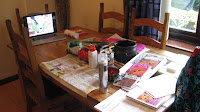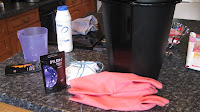I’ve been taking care of my younger brothers this week whilst my parents were away for their wedding anniversary. And so I have taken the perfect opportunity to mess up the kitchen and turn it into my mini-studio to work at home from whilst I’m in dire need of a decent desk.

It may look cluttered, but this is tidy to me and I’ve never felt so humbled. I’m sad to have to tidy it all away tonight now that the parents are home.
However, it has allowed me to do a lot of work, particularly on my Bookjacket project. This week I missed the traditional media workshop, in which my tutor promised to take a look at my use of watercolours and acrylics. So I had to take it upon myself to practice and experiment. Which I did. And I loved it!
Acrylics are so pliable! Once they’ve dried you can layer them on top of one another without losing or changing the colour. I find my favourite effects come with using a dry brush, which gives me a real grungy, rough stroke.

As well as acrylics I have also tried many other media to try and evoke the right feeling for my World of Spiders Bookjacket. Try and guess which media I used where…




My personal favourite though has to be this one.

I love the bold neon colours, they’re eccentric and really punk rock! And much more colourful and imaginative than anything else I’ve come up with.
Just one more week of printmaking and I should have at least one final Bookjacket design if not three different ones (digital, traditional, screen/lino printed). As for the 3D model that refers to the Bookjacket brief, I am doing something a little different, stay tuned for a blog on that later.
As well as working on my uni work I also took some time out for three cans of Monster Energy and some good old-fashioned hippie tie-dying.
I haven’t tie-dyed since my girlhood days of Brownies and Guides, where I made a blue hankie. It was awesome.
But my latest project is much cooler.
I started by buying myself some Dylon hand-dying powder from an art shop. It was less that £6 for two packets, so I grabbed yellow and violet, the colour my hair used to be, and one of my favourite colour combinations. Then I bought a cotton vest from Tesco for £3. Sweet!

I washed my vest to get rid of any impurities, then I followed the pack instructions… almost. I decided I wouldn’t need two full packs of dye for one tiny vest, so I halved everything. Where the pack told me to dissolve the powder in 500ml of water, I dissolved only half the pack in 250ml of water, and so on. So when I tell you how I did it, keep in mind the measurements have all been reduced by 50%.

After dissolving my dye in warm water I got a fresh bucket and filled it with three litres of warm water. Warm meaning it was hot but I could easily put my hand in it. Then I added 2 ½ - 3 tablespoons of regular table salt. The salt helps to open up the pores in the clothes, enabling it to take on the dye more easily.



Once the salt had dissolved I pored my ready made dye into the bucket of warm water and mixed it well.

Now for the creative part. I decided to go for a swirl pattern on my vest. There are many patterns and you can find them online, or on youtube videos, particularly
this one. Basically I just pinched the (damp) fabric and twisted it. Then I used some string to tie it up really tight into a little bundle.


When I was happy with the bundle I dropped it into the diluted-dye mixture. The pack asked me to stir continuously for 15 minutes, then occasionally for a further 45 minutes, so that the fabric is steeped for a full hour. But obviously you don’t have to be so anal, they’re just guidelines.

After about an hour I poured the water away and rinsed the bundle under cold water until it ran clear. Then I rinsed it further in warm water. When I was happy that the dye was fixed I squeezed out any excess water and left it damp, ready to go again.

I repeated the entire process, this time with the yellow dye. All the advice reads that you dye using your darkest colour first, finishing with the lightest.

The only thing I changed this time besides the colour was the pattern. I twisted and contorted the fabric a different way, aiming the get any white fabric dyed yellow for a nice mix. Then I dropped the bundle into the dye again and gave it an hour.



After cleaning and rinsing the fabric, and feeling chuffed with my work, I left the vest to dry. I’d been advised not to use direct heat or sunlight for this.
Finally, I ironed my vest to fix the dye and… well you can see the results for yourself!

It was an easy, hassle-free process, cheap and the results are fantastic! I’ll be doing a towel for my holidays, a shirt for my sister and some bed sheets to brighten up my bedroom. For these I would like to further my understanding of the process in order to create other patterns, effects and even images with the dye.
In the words of Neil Buchanan, “Try it yerself!”



